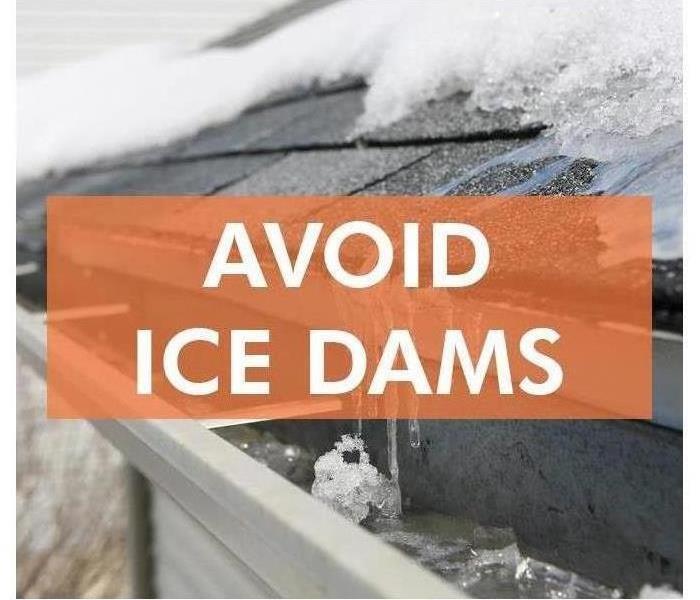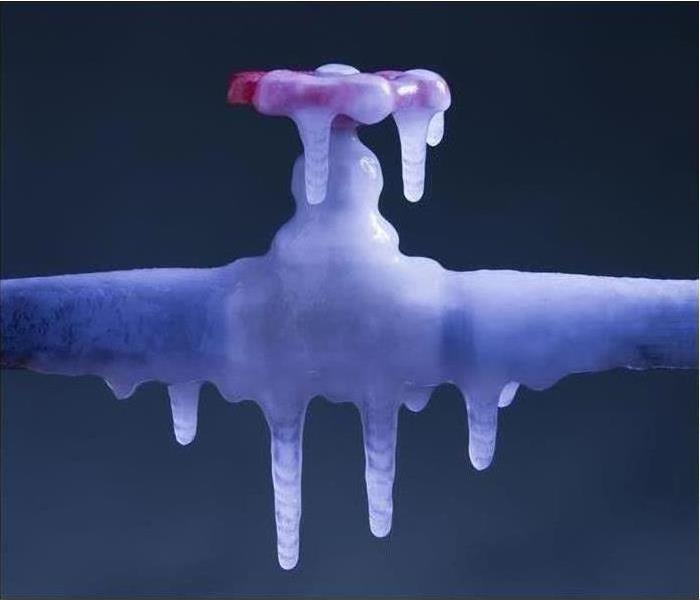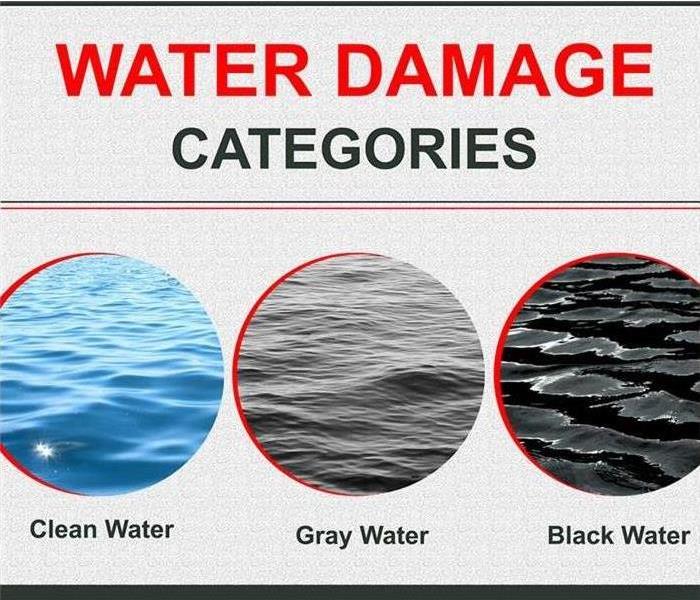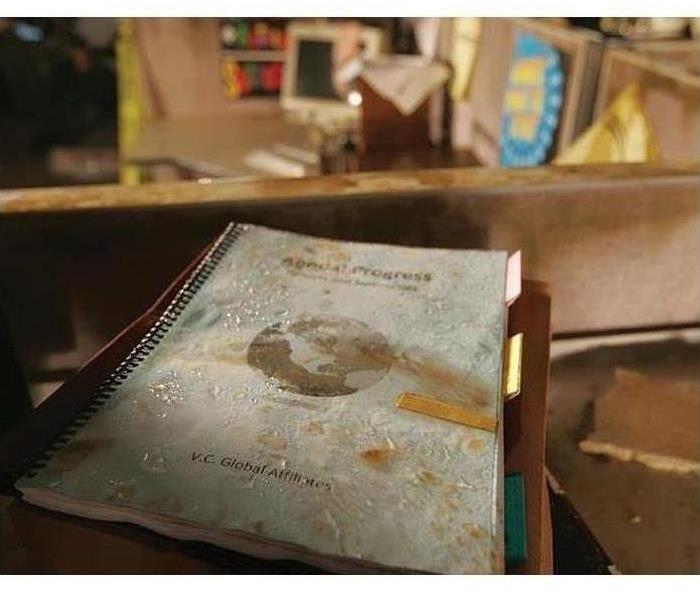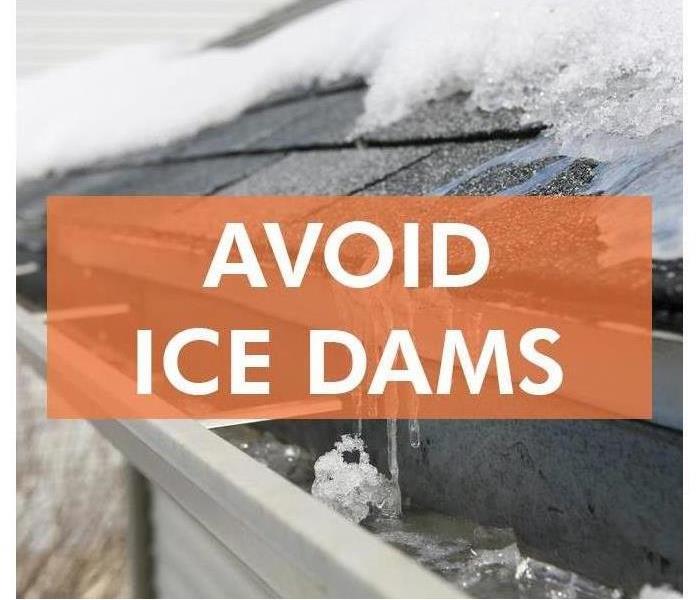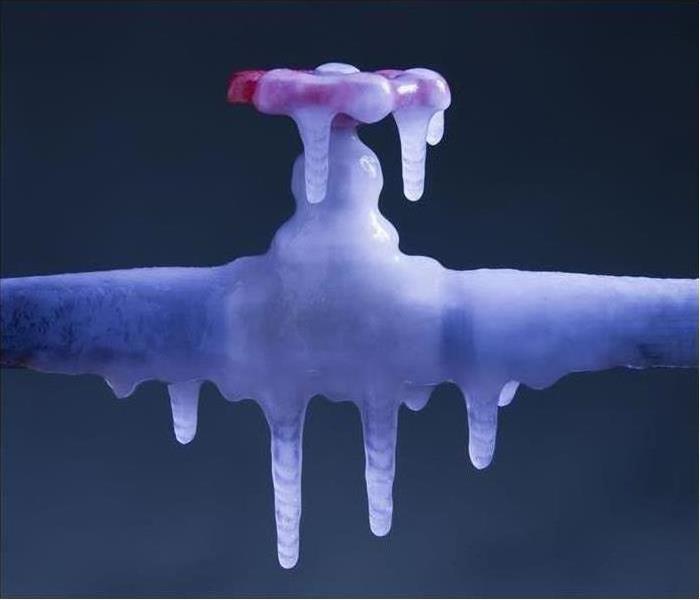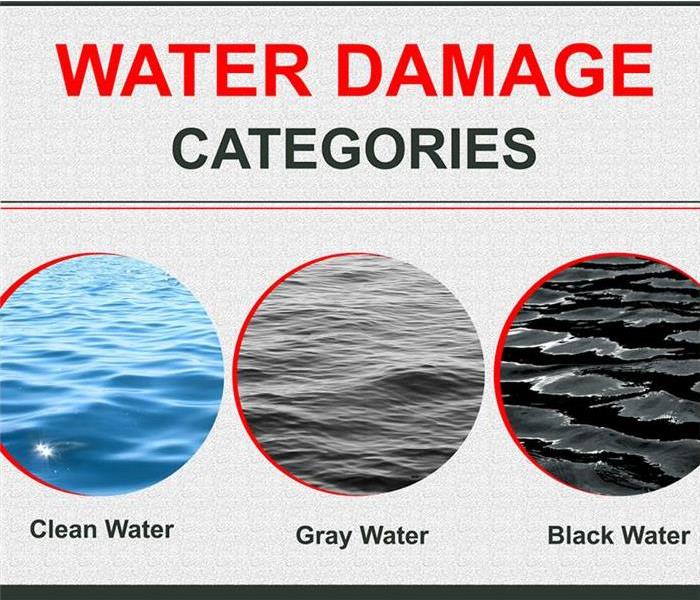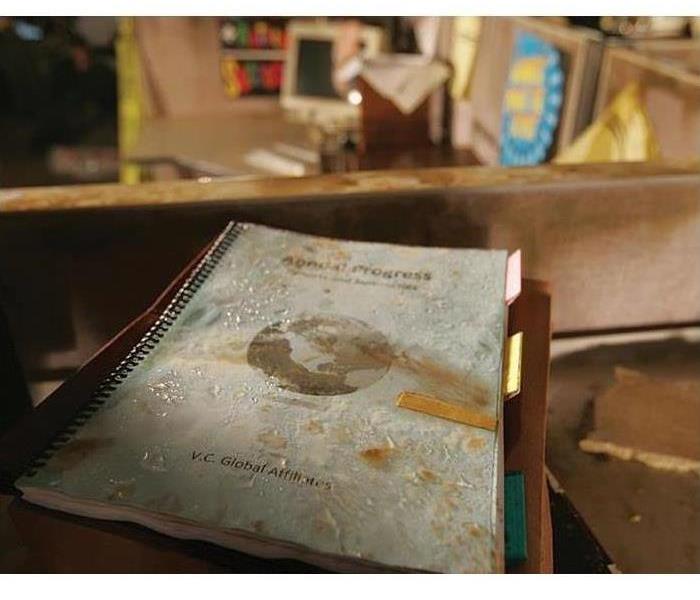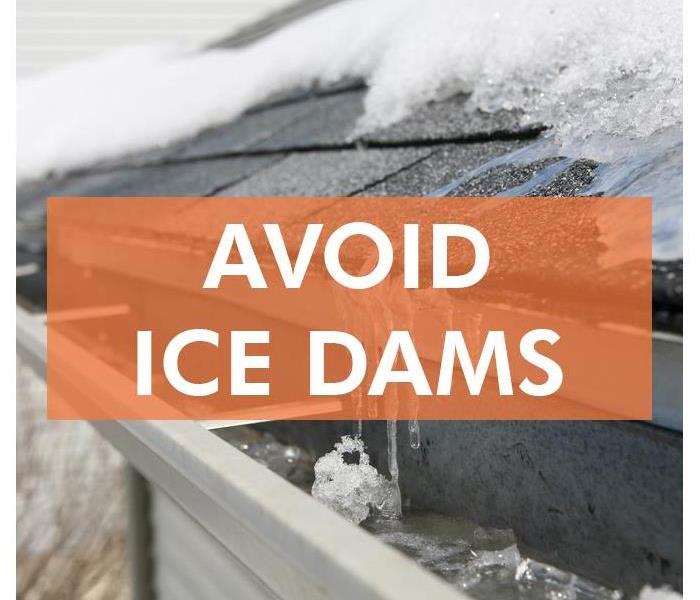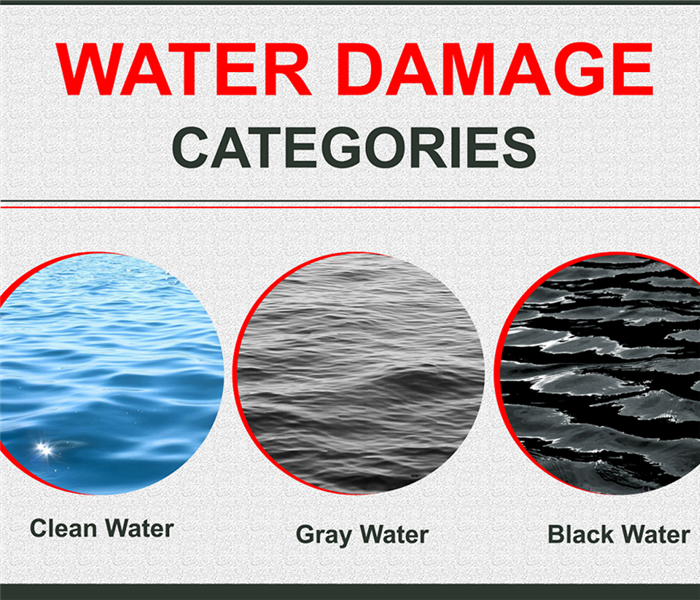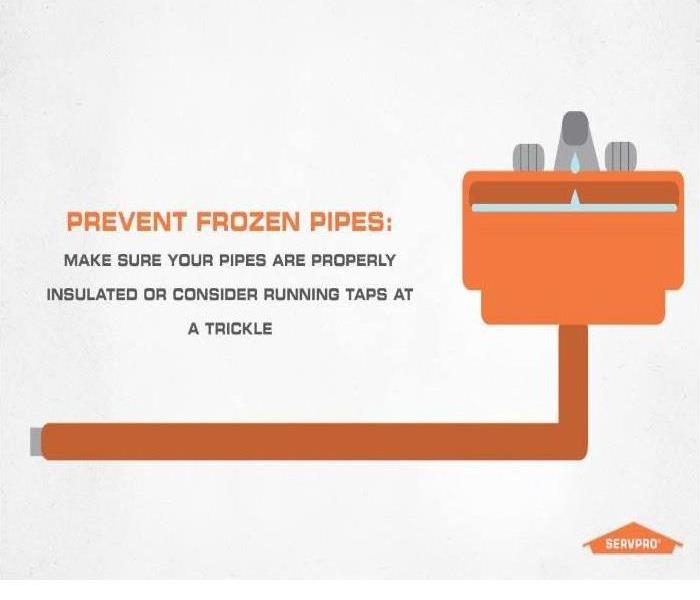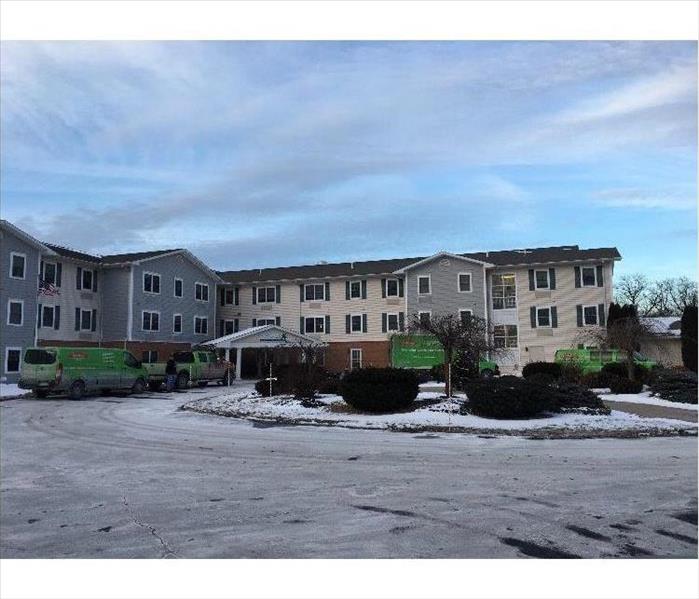Archived Water Damage Blog Posts
Do you know the three categories of water damage?
12/24/2022 (Permalink)
Water damage comes in the form of three different categories. The main difference between these categories is how polluted or unsanitary the water is. The higher the category, the more pollutants can be found within.
The first category of water damage is the most common occurrence and is called Clean Water loss. The water in a category one loss is relatively clean and mostly free of pollutants that are dangerous to handle or ingest. Cleaning and restoration work can be done quickly when dealing with this category of water loss.
The second category of water damage is known as Gray Water. Gray water contains a moderate amount of contaminants inside and can cause illness and discomfort for any that may accidentally ingest it. Water sources that produce gray water are things like dishwashers, toilet overflows that contain urine, and other types of "used" water.
The final category of water damage is Black Water which deals with water from dangerously unsanitary sources. When dealing with water from this category, serious illness and even death are potential dangers should it be ingested. Black water-producing sources are things like sewage backups, rising river or stream water, floodwater, and toilet water containing fecal matter.
Combating water damage is more than simply removing the water from your home. Knowing what could potentially be in the water, and how to properly handle it helps homeowners know where and how to start with any water emergency!
Is your home prepared to combat ice damming?
12/16/2022 (Permalink)
As the temperature starts to drop and rain turns to snow and sleet, ice dams become a larger threat to property. When snow and sleet on the roof of a house go through quick bouts of melting and refreezing it can create a wall of ice, this ice wall then acts as a dam when more snow and sleet begin to melt. These dams can last for weeks or even months unless dealt with. As water pools along dams, it can begin to work its way under the shingles. When the water that has worked its way in freezes, the gaps created by the ice allow even more water to work its way into the property, causing all sorts of water damage!
There are few preventative measures that can be taken to combat ice damming. One method is to run heating cables in your attic that go along the sections of the roof that have the most trouble with dams forming!
When ice dams are forming on your property, it can indicate that the insulation in your home is failing. You can check the attic beneath problem areas on the roof for any inconsistencies. Retaining heat in the attic is the natural way to combat ice damming and can even keep your home a bit warmer during the cold winter months.
Stay safe this winter season, and if you intend on directly dealing with any problems you or your family are facing be sure to be careful. Many instances of people getting hurt while they are attempting to help themselves or their family is due to negligence.
Water Damage Doesn't Always Mean the End for Your Papers and Documents!
8/4/2022 (Permalink)
When water makes its way into your home, few things are left untouched. If important documents and papers are among the list of damaged items, it may be possible to fully or partially restore them if you act quickly!
When paper documentation is in a water loss, the faster restoration work begins, the higher the likelihood that restoration can be achieved. SERVPRO keeps any papers undergoing restoration work locked away in our facilities to ensure their safety!
When logging the damaged items and papers in the water loss, try your hardest not to touch or mishandle them in any way. Professionals can safely remove damaged documents with less risk of irreversible damage. Water-damaged papers are extremely fragile and even the slightest movement can damage them even further, potentially preventing their restoration!
2022 Water Damage Categories
7/4/2022 (Permalink)
Every year during the Summer months there is a noticeable increase in severe weather and potential property damage. Due to this increase, it is important to know the differences between the various categories of water damage your property may face. There are distinct signs within each category that help to quickly identify them, but also distinct dangers!
The first category of water damage is when a water loss consists of clean and/or sanitary water sources. Things like water lines, faucet leaks, water fountains, and toilet tanks are all examples of this type of water source. When dealing with a category 1 water loss, there usually isn't more to it than the water damages that your property faces.
The second category of water damage occurs when a water loss consists of water sources with a level of contaminants that can potentially cause illness if ingested. Water sources like dishwashers, overflowing toilets while there is urine in them, and other sources with "used" water are all examples of a category 2 water loss.
The final category of water damage consists of water that comes from dangerously unsanitary sources with high levels of contaminants. You face serious illness or potentially death if water from these sources is ingested. Water from a sewer backup, flooded rivers or streams, overflowing toilets containing feces, and stagnant water that has bacterial growth all fall under the category 3 water loss umbrella.
It is critical to fully grasp and understand the differences between water loss categories, as knowing so can help prevent potential illness when dealing with them. Be ready for any disaster that may come your way!
Be safe and remember, SERVPRO is here to help!
Are You Taking the Proper Steps to Prevent Water Damage?
6/22/2022 (Permalink)
According to statistics, up to 93% of water damage losses can be prevented. Not only is SERVPRO able to help prevent water damage from occurring, but our specialists are highly trained in repairing and restoring any damages that do occur!
When aiming to prevent water damage, one of the first steps is to inspect and strengthen the most common locations where water can invade your home. Cracked roofing, aging or poor window sealant, or even leaky piping are places that should be inspected for potential problems!
Once you've taken note of any suspect areas, it's time to take action. By working proactively and attacking a potential problem head-on, you can significantly decrease the likelihood of needing work reactively in the future!
Just remember that SERVPRO is always here to help whenever you need it most. We're just a call away!
Ice dams forming on your roof can lead to winter water damage!
12/27/2021 (Permalink)
Ice dams start to form during the colder months of the year. It starts when snow begins to melt and then refreezes and creates a wall. As this process repeats it begins to form a sort of dam. These dams will grow larger and larger until they are removed or the weather warms up for a lengthy period. These dams cause property damage by getting water into and under tiles/shingles and then freezing, which shifts them to create an opening! From here water can make its way into the home and cause all sorts of damages.
There are a few ways to take preventative measures against this though. Run heating cables in your attic that go along the sections of the roof that have the most trouble with dams forming. This helps prevent the water from being able to refreeze in bad areas.
Ice dams beginning to form also usually means that the attic of the house is leaking heat due to improper insulation. Take note of where the dams are forming on the roof and check that same area of the attic for inconsistencies! Trying to retain the heat in your attic is the natural way of combatting damming ice and can even help keep your house warmer overall.
Stay safe this winter season, and if you intend on directly dealing with any problems you or your family are facing be sure to be careful. Many instances of people getting hurt while they are attempting to help themselves or their family is due to negligence.
Prevent Winter Water Damage!
11/4/2021 (Permalink)
The temperature outside is starting to drop, so it is a great time to take the initiative and inspect or make changes throughout your home so that it is safe from potential winter water damage!
Firstly, it is important to take some time and check your home's water pipes to see whether or not you may need to make some changes, checking for insulation should be where you start. If your pipes have already been insulated then you're already a step ahead of the curve and your home will be safer for it.
First, it's important that you take the time to thoroughly check the water pipes situated throughout your home. It is important to figure out whether or not they are insulated so that you know if they are protected from the cold winter temps. If they already are, you are a step ahead of the curve and have much less to worry about as the cold weather moves in!
Second, if you've discovered that the piping throughout your home is not already insulated then you should take the time to look into it. Insulated pipes help prevent freezing and pipe bursts by keeping them and their contents from getting too cold.
Lastly, there are other precautionary measures that you can take to prevent potential winter water damage. By running your tap at a trickle the water in your pipes will continue to flow at a rate that makes it much harder for it to freeze and lead to a pipe burst!
By using these few tips you can help ensure that your home is protected from wintertime water damage!
Do you know the different types of water damage that can affect your home?
10/5/2021 (Permalink)
When your home or business faces a water loss it can be rough. When estimating the damages, the category of the water is extremely important. Dirty, polluted water can lead to an increase in damages and often requires more work to restore and clean than if the damage was done by relatively clean water.
The first type of water damage is the one that occurs the most, as it comes from a clean or sanitary source. For example, leaky water pipes, faucets, and fountains. This type doesn't bring about as many variables when it comes to cleaning and restoring the damage done.
The second type of water damage is a water loss that contains some contaminants inside of it. These contaminants can cause illness and discomfort if ingested. A few examples of water loss sources that would be classified under this type are things like dishwashers, toilet overflows with urine, and other "used" water sources.
The third and final water damage type comes from water sources that are deemed to be dangerously unsanitary/heavily contaminated. Water from these sources can cause serious illness and even lead to death if unknowingly ingested. Examples of water sources that can lead to this type are things like sewage backup, floodwater, rising waters from rivers or streams, and dirty toilet water.
Knowing the differences between the types of water damage can aid you in the future. Knowing what to avoid and what is safe to work on clearing can keep you free from potential illness and allow you to properly react to any possible water emergency!
It may not be the end for your damaged papers and documents!
8/5/2021 (Permalink)
Water damage leaves few things unscathed. Important books and records for your home, bank, job, business, etc are often able to be fully or even partially restored, however.
The faster that important paper documents are salvaged from the water loss the higher the likelihood that the process to restore them will work! By keeping your documents in our facilities, we're able to keep a close eye on them to ensure that the restoration process goes off without a hitch.
If you ever do find yourself with water damage and damaged documents in your home it is important that you do NOT touch any of the papers that may need restoration. Any paper that has been damaged will be extremely fragile and can be easily damaged further accidentally!
Categories of Water Damage 2021
7/5/2021 (Permalink)
With the yearly uptick in severe weather that we see during the Summer months, it is important to know and understand the differences in each category of water damage that your home or business may face. Each category has distinct signs that help you identify them, but also distinct dangers to you and others!
Category 1 water damage is considered to be a water loss that comes from clean and/or sanitary sources. Examples of these are water lines, faucets, toilet tanks, fountains, etc. This category normally doesn’t cause any issues other than the damage to your property from the water.
Category 2 water damage is considered to be a water loss that comes from sources with levels of contaminants that can potentially cause illness or discomfort if ingested. Some examples of sources that would cause this are dishwashers, toilet overflow with urine in it, or other sources with “used” water.
Category 3 water damage is considered to be a water loss that comes from sources that are deemed to have dangerously unsanitary contaminants. These can cause serious illness or even death if ingested. This includes water damage caused by sewer backup, flooding from rivers or streams, toilet overflow containing feces, and stagnant water with bacterial growth.
Fully grasping and understanding the differences between these categories and properly using that knowledge when needed is both extremely important and beneficial. Be ready for any disaster that may come your way!
Be safe and remember, SERVPRO is here to help!
Water Damage is Preventable! Learn the Steps to Prevent it and Take Action!
6/23/2021 (Permalink)
Statistics show that up to 93% of water damage losses can be prevented before they even occur. Not only can SERVPRO help prevent water damage but our Specialists are highly trained and properly equipped to restore any that does occur!
Be on the lookout for leaky roofs, possible window seals that may need to be replaced, flooding, malfunctioning sprinklers, and other signs that could help stop potential water damage in its tracks. It's important to make a habit of inspecting different areas of your property to make sure that your home or business is in the safest condition that it can be when dealing with the unknown. From checking roof tiles to making sure your water pump is working properly, all of the possible steps you can and should take will make your home or business ready for whatever gets thrown its way!
Remember, SERVPRO is always here to help you when you need it most, all you need to do pick up the phone!
Take Care of Ice Dams and Stop Winter Water Damage!
12/28/2020 (Permalink)
Ice dams are built up walls of ice that normally form when snow is beginning to melt and is then refrozen. These walls have the possibility to form in a way that makes them direct the flow of other melting snow into places where it can cause damage, under the shingles on your roof for instance. These large walls of ice are something to be on the lookout for, taking note of where the sun tends to hit your roof is step one of the process. If you notice that the lower areas of a specific part of your roof don't receive much sunlight that means that it is prime ice dam forming territory. If your roof has any areas like this then it is only a matter of time before water makes its way in and causes damage to your home.
There are ways to prevent this though. Get heating cables and running them along the opposite side of any problem locations, throughout your attic. This will keep the areas where pooling and ice forming to a much smaller degree. Instead of gradually building in size it will be able to now properly drain out of your gutters.
The forming of ice dams also tends to mean that the attic of your home is not keeping the heat where it needs to be. This can be fixed by having professionals come in, take note of the area, and installing more insulation where needed to help lock in the heat your house is already producing. This is a natural way to combat ice damming, as the increase in average temperature in the attic can be the one thing that is preventing any water from icing over.
Stay safe this winter season, and if you intend on directly dealing with any problems you or your family are facing be sure to be careful. Many instances of people getting hurt while they are attempting to help themselves or their family are due to negligence.
Prevent water damage in your home this Winter!
11/5/2020 (Permalink)
As the weather begins to cool down over the winter months it is a great idea to take the initiative and begin making some changes or simply get some things checked out to make sure that your home is safe from unwanted water damage.
Firstly, it is important to take some time and check your home's water pipes to see whether or not you may need to make some changes, checking for insulation should be where you start. If your pipes have already been insulated then you're already a step ahead of the curve and your home will be safer for it.
Secondly, if you don't have insulation on your piping you need to look into getting that changed. This will help keep your pipes warm enough so that they don't freeze over and eventually break due to extreme cold.
Thirdly, take extra precaution by running your tap at a trickle, this will keep water flowing and help mitigate ice forming in or around your pipes!
By using these few tips you can help ensure that your home is protected from winter time water damage!
Water Damage Categories 2020
10/7/2020 (Permalink)
Water losses in a home or business can be rough; the amount of damage can rise significantly depending on the type of water that caused the damage. Dirtier water can lead to more damages and require more restoration and cleaning than if the damage was caused by clean water.
The first type of water damage that is most common is a water loss that comes from a clean or sanitary water source. Some examples of this would be things like water pipes, faucets, and fountains. This type of water damage normally doesn't cause extra damage other than the initial water damage.
The second type of water damage is a water loss that contains some contaminants inside of it. These contaminants can cause illness and discomfort if ingested. A few examples of water loss sources that would be classified under this type are things like dishwashers, toilet overflows with urine, and other "used" water sources.
The final type of water damage is a water loss that comes from sources that are deemed to have dangerously unsanitary contaminants. These water sources can cause serious illness and even possibly death if ingested. Water damage sources that provide this category of damage are things like sewage backup, flood water from rivers or streams, toilet overflow with feces in it.
It is important to know the differences in the types of water damage and what potential dangers they pose to you or your family. This knowledge should hopefully give you the ability to properly react at a moments notice to whatever water damage you are facing.
Books and personal records damaged by water aren't a lost cause!
8/6/2020 (Permalink)
Water damage leaves few things unscathed. Important books and records for your home, bank, job, business, etc are often able to be fully or even partially restored however.
By acting quickly, if we gather any important documents that have noticeable damage done to them and begin work on restoring them the likelihood of the process worked increases exponentially. We can then bring those items to our offices/warehouses to properly go over them and make sure that they get the proper attention they need to be fully restored and to help you avoid losing hours of work.
Make sure that if you do have a water loss, and you know that you have paperwork that was damaged, to NOT touch the items that you wish to be restored as they are extremely fragile and can easily become much more damaged than they originally were.
Water Damage Categories 2020
7/8/2020 (Permalink)
The constant threat of severe Summer storms shows that it is important to know the differences of the many different categories of water damage that you could potentially face in your home or business. Each category offers a different level of damage and danger.
Category 1 water damage is considered to be a water loss that comes from clean and/or sanitary sources. Examples of these are water lines, faucets, toilet tanks, fountains, etc. This category normally doesn’t cause any issues other than the damage to your property from the water.
Category 2 water damage is considered to be a water loss that comes from sources with levels of contaminants that can potentially cause illness or discomfort if ingested. Some examples of sources that would cause this are dishwashers, toilet overflow with urine in it, or other sources with “used” water.
Category 3 water damage is considered to be a water loss that comes from sources that are deemed to have dangerously unsanitary contaminants. These can cause serious illness or even death if ingested. This includes water damage caused by sewer backup, flooding from rivers or streams, toilet overflow containing feces, and stagnant water with bacterial growth.
Understanding the differences between these categories and using that knowledge when needed if you were to encounter water damage in your home or business is extremely important.
Be safe and remember, SERVPRO is here to help!
Water Damage is Preventable! Learn How to Prevent it and Take Action Today!
6/26/2020 (Permalink)
Statistics show that 93% of water damage losses can be prevented before they occur. With training and experience that the specialists at SERVPRO obtain and the utilities that they are given to deal with it help make SERVPRO inform others in dealing with water damage losses we know how to properly prevent. Not only can SERVPRO prevent damage from occurring but we can restore and replace things that were.
Losses involving leaky roofs, windows seals needed replacement, flooding, malfunctioning sprinklers and many more are the types of things to be on the lookout for. It's important to take some time every few months or years to make sure that your home or business is in the safest condition it can be when dealing with the unknown, from checking roof tiling to making sure water pumps are working 100% correctly, all of the possible steps you can and should take will leave your home and business in a safe and comfortable place.
Remember, SERVPRO is here to help you in your time of need, all you need to do is call!
Water damage from ice dams can be costly!
1/1/2020 (Permalink)
Ice dams are quite literally dams of ice that form during the Winter months inside of your property's gutters or roofing. The water runoff from any snow that has accumulated on your roof can pool in your gutters and build up as ice. As these areas build up they end up creating what we know to be ice dams. Ice dams will continue to block the path of any water that is running off of your roof and can force it to begin pooling in and around the shingles of your roof. Once this has begun it is only a matter of time before the water is able to force it's way inside your roofing and beginning to damage both your roof and potentially deeper inside of your home.
There are ways to prevent this though. Get heating cables and running them along the opposite side of any problem locations, throughout your attic. This will keep the areas where pooling and ice forming to a much smaller degree. Instead of gradually building in size it will be able to now properly drain out of your gutters.
The forming of ice dams also tends to mean that the attic of your home is not keeping the heat where it needs to be. This can be fixed by having professionals come in, take note of the area, and installing more insulation where needed to help lock in the heat your house is already producing. This is a natural way to combat ice damming, as the increase in average temperature in the attic can be the one thing that is preventing any water from icing over.
Stay safe this winter season, and if you intend on directly dealing with any problems you or your family are facing be sure to be careful. Many instances of people getting hurt while they are attempting to help themselves or their family are due to negligence.
Take action and prevent Winter water damage in your home!
11/7/2019 (Permalink)
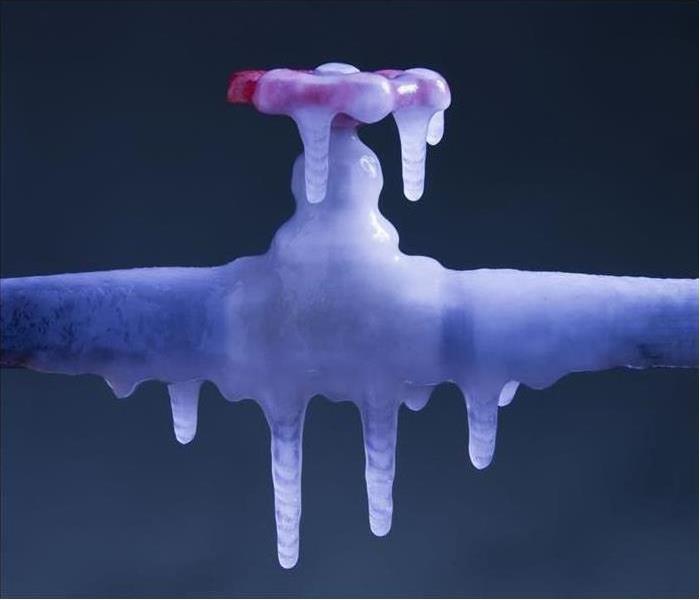 Prevent frozen pipes in your home!
Prevent frozen pipes in your home!
As the weather begins to cool down over the winter months it is a great idea to take the initiative and begin making some changes or simply get some things checked out to make sure that your home is safe from unwanted water damage.
Firstly, checking your home's water pipes to see whether or not you need to make some changes is important, checking for insulation should be where you start. If your pipes have already been insulated then you're already a step ahead of the curve and your home is safer for it.
Secondly, if you don't have insulation on your piping you need to look into getting it done. This will help keep your pipes warm enough so that they don't break due to extreme cold.
Thirdly, take extra precaution by running your tap at a trickle, this will keep water flowing and help mitigate ice forming in or around your pipes!
Use these few tips to help ensure that your home is protected from winter time water damage.
The Different Categories of Water Damage
10/10/2019 (Permalink)
Water losses in a home or business can be rough, the amount of damage can rise significantly depending on the type water that caused the damage. Dirtier water can lead to more damages and require more restoration and cleaning than if the damage was caused by clean water.
The first type of water damage that is most common is a water loss that comes from a clean or sanitary water source. Some examples of this would be things like water pipes, faucets, fountains. This type of water damage normally doesn't cause extra damage other than the initial water damage.
The second type of water damage is a water loss that contains some contaminants inside of it. These contaminants can cause illness and discomfort if ingested. A few examples of water loss sources that would be classified under this type are things like dishwashers, toilet overflows with urine, and other "used" water sources.
The final type of water damage is a water loss that comes from sources that are deemed to have dangerously unsanitary contaminants. These water sources can cause serious illness and even possibly death if ingested. Water damage sources that provide this category of damage are things like sewage backup, flood water from rivers or streams, toilet overflow with feces in it.
These types of water damage and their differences are important to know for all home and business owners. This knowledge will give you the ability to properly act if a water loss knocks on your door.
Water damaged books and personal records CAN be repaired!
8/3/2019 (Permalink)
Water damage leaves nothing untouched and most things un-repairable. Important books and records for your home, bank, job, business, etc are often able to be restored however.
SERVPRO specializes in mold remediation and that means that we are able to come to your place of work or home and gather the items that need to be restored. We can then bring those items to our offices/warehouses to properly go over them and make sure that they get the proper attention they need to be fully restored and to help you avoid losing hours of work. Make sure that if you do have a water loss, and you know that you have paperwork that was damaged, to NOT touch the items that you wish to be restored as they are extremely fragile and can easily become much more damaged than they originally were.
Water Damage Categories 2019
7/11/2019 (Permalink)
With the constant threat of severe storms during the Summer it is important to know the differences of water damage that you could face in your home. Each category offers a different level of danger and reason to be wary.
Category 1 water damage is considered to be a water loss that comes from clean and/or sanitary sources. Examples of these are water lines, faucets, toilet tanks, fountains, etc. This category normally doesn’t cause any issues other than the damage to your property from the water.
Category 2 water damage is considered to be a water loss that comes from sources with levels of contaminants that can potentially cause illness or discomfort if ingested. Some examples of sources that would cause this are dishwashers, toilet overflow with urine in it, or other sources with “used” water.
Category 3 water damage is considered to be a water loss that comes from sources that are deemed to have dangerously unsanitary contaminants. These can cause serious illness or even death if ingested. This includes water damage caused by sewer backup, flooding from rivers or streams, toilet overflow containing feces, and stagnant water with bacterial growth.
It's important to understand these differences and us that knowledge if you so need it in the event of water damage on your home.
Be safe and remember, SERVPRO is here to help!
Help Prevent Water Damage in Your Home!
6/21/2019 (Permalink)
Statistics show that 93% of water damage losses can be prevented before they occur. With training and experience that the specialists at SERVPRO obtain and the utilities that they are given to deal with it help make SERVPRO inform others in dealing with water damage losses we know how to properly prevent. Not only can SERVPRO prevent damage from occurring but we can restore and replace things that were.
Losses involving leaky roofs, windows seals needed replacement, flooding, malfunctioning sprinklers and many more are the types of things to be on the lookout for. It's important to take some time every few months or years to make sure that your home or business is in the safest condition it can be when dealing with the unknown, from checking roof tiling to making sure water pumps are working 100% correctly, all of the possible steps you can and should take will leave your home and business in a safe and comfortable place.
Remember, SERVPRO is here to help you in your time of need, all you need to do is call!
Frozen pipes? No problem!
12/15/2018 (Permalink)
Winter is on its way but the cold temps are already here. Frozen pipes are one of the most common issues home owners can face during the winter months. If your home has a tendency of having water pipes freeze over during winter months there are a few ways you can try to clear up that blockage!
1). Keep the faucet dripping. This will help ease your pipes into having water flowing properly again.
2). Apply heat to the affected section of the pipe with a heating pad or hair dryer. Doing this will slowly thaw out any ice that has formed in the pipe.
3). Apply heat until full water pressure is restored.
Finally, if you noticed that you are still having problems after all of this it is probably best that you contact your nearest licensed plumber to come and take a look at it.
Winter Pipe Bursts Can Be Prevented
11/9/2018 (Permalink)
When the weather starts to get colder during the winter months it is a good idea to start taking initiative and make some changes or check some things to make sure your home is safe from unwanted water damage. Firstly, you're going to want to check your home's water pipes to see whether or not you need to make some changes. If your pipes have already been insulated then you're already a step ahead of the curve and your home is safer for it. Secondly, if you don't have insulation on your piping you need to look into getting it done. This will help keep your pipes warm enough so that they don't break from extreme cold. Thirdly, you can take extra precaution by running your tap at a trickle, this will keep water flowing and help mitigate ice forming in or around your pipes! Use these few tips to help ensure that your home is protected from winter time water damage.
Categories of Water Damage
10/24/2018 (Permalink)
Having a water loss in your home can be much more damaging and dangerous depending on what category of water damage your loss is. These categories range from 1 to 3 and the differences could mean life or death depending on the circumstances.
Category 1 water damage is considered to be a water loss that comes from clean and/or sanitary sources. Examples of these are water lines, faucets, toilet tanks, fountains, etc. This category normally doesn’t cause any issues other than the damage to your property from the water.
Category 2 water damage is considered to be a water loss that comes from sources with levels of contaminants that can potentially cause illness or discomfort if ingested. Some examples of sources that would cause this are dishwashers, toilet overflow with urine in it, or other sources with “used” water.
Category 3 water damage is considered to be a water loss that comes from sources that are deemed to have dangerously unsanitary contaminants. These can cause serious illness or even death if ingested. This includes water damage caused by sewer backup, flooding from rivers or streams, toilet overflow containing feces, and stagnant water with bacterial growth.
It is important to know the differences between these damage categories so that you know what to do and how to act if you are in a situation involving water damage to your home or other property.
Water Pipe Break at Local Church
2/3/2018 (Permalink)
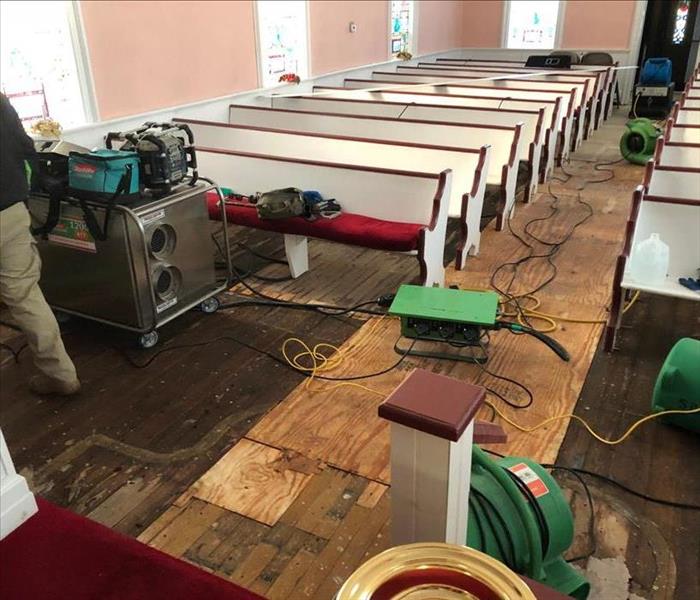 Church during clean up of water pipe break.
Church during clean up of water pipe break.
With the cold winter air affecting your pipes its important to maintain them properly! We recently got called out to help a local church that lost heat and suffered from multiple pipe breaks. Water pipes that break due to the cold weather can cause severe damage to your home or business if left unattended or unnoticed. If you notice a loss in pressure to some of your appliances that use water or notice water damage or mold in specific areas of your home/business it is important to get it looked at as quickly as possible. We were able to get to this local church in time to fix the problem for them and be on our way! Remember to stay observant and to be wary of anything that could be wrong in your home or business.
Sprinkler Head Break at Senior Living Home
2/3/2018 (Permalink)
Some of our specialists were recently called out to a senior living home to help fix a sprinkler head break that caused some water damage to the home. It is important to know that during the winter the cold air outside often causes the pipes in our homes to get very fragile, which in turn causes them to break easily, often times caused by the pipes being heated back up and not being able to withstand the pressure in the pipe due to the cold. Our crews were called out and were able to quickly deal with the water both it was able to cause any severe or permanent damage to the home.
SERVPRO of Hanover Township/Bear Creek 24 hour Emergency Water Damage Service
8/23/2017 (Permalink)
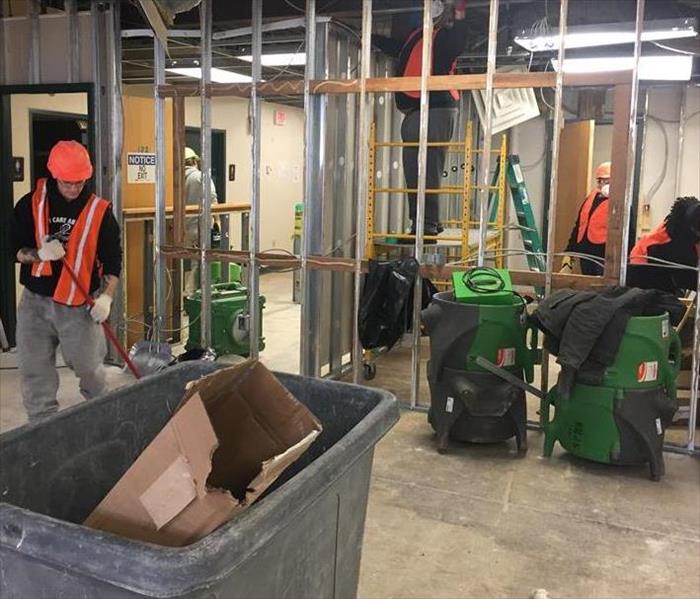 Commercial Fire & Water Damage in Wilkes-Barre, Pennsylvania.
Commercial Fire & Water Damage in Wilkes-Barre, Pennsylvania.
SERVPRO of Hanover Township/Bear Creek is available 24 hours a day for water damage emergencies, large or small. When you are dealing with water damage, immediate action is crucial. A delay of just a few hours can greatly increase the severity of the water damage.
We Answer the Phone Ready to Help
Call Today -570-822-4700
We understand that when you call us, you may be feeling confused, stressed, and vulnerable. You need an expert to guide you through this crisis. SERVPRO of Hanover Township has the specific water damage training and experience to help you through this tough time. We specialize in water damage restoration. In fact, it's the cornerstone of our business.
What to Expect
When you call, we will ask several questions regarding your water damage emergency. These questions will help us determine what equipment and resources to bring, including how many trained SERVPRO Professionals may be needed.
Our SERVPRO Representative will ask several questions:
- Your name and contact information
- Your insurance information (if applicable)
- The street address of the water-damaged home or business
- When did the flooding or water damage occur?
- What caused the water damage (if known)?
- Is there electricity available (on-site)?
About SERVPRO of Hanover Township/Bear Creek
SERVPRO of Hanover Township/Bear Creek specializes in the cleanup and restoration of residential and commercial property after a fire, smoke or water damage event. Our staff is highly trained in property damage restoration. From initial and ongoing training at SERVPRO's corporate training facility to regular IICRC-industry certification, rest assured our staff is equipped with the knowledge to restore your property.
Freezing temps without frozen pipes!
1/29/2017 (Permalink)
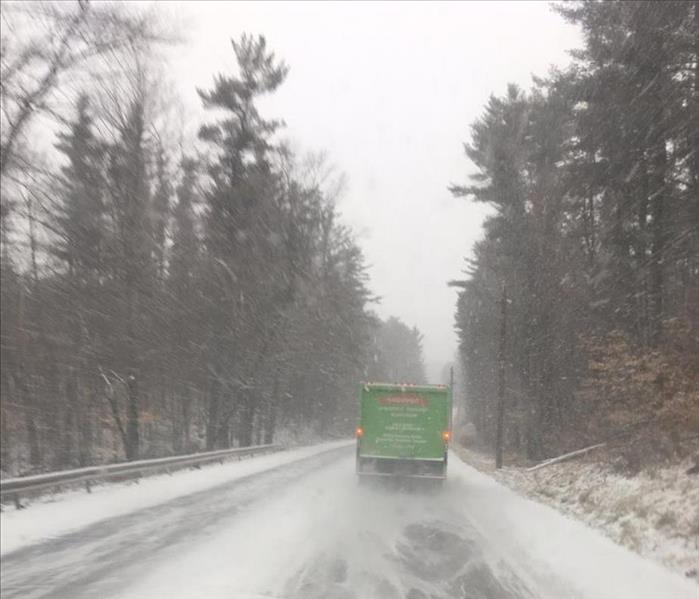 Crew responding to a water damage during snow storm.
Crew responding to a water damage during snow storm.
Our technicians at SERVPRO of Hanover Twp/Bear Creek will be there to help you in your time of need, even in the worst of conditions. When the Polar Vortex engulfed the Northeastern Pennsylvania area over the winter our crews were ready to respond when the calls came in. When leaving your home for an extended period of time during the winter, be sure to take proper steps to ensure your pipes wont freeze. Make sure your water is turned off completely or at least to areas of the home prone to cold temperatures. Keep your thermostat on and at a temperature that will prevent your pipes from failing. Have a neighbor or friend check on your residence while you are away. Small things can be done before you leave to prevent big problems when you return.
Faster to your Hanover Township/ Bear Creek Water Damage Event
5/12/2016 (Permalink)
Flooding and water emergencies don’t wait for regular business hours and neither does SERVPRO of Hanover Twp/ Bear Creek. We provide emergency cleaning and restoration services 24 hours a day, 7 days a week—including all holidays.
Faster To Any Size Disaster
Flooding and water damage is very invasive. Water quickly spreads throughout your home and gets absorbed into floors, walls, furniture, and more. SERVPRO of Hanover Township/ Bear Creek arrives quickly and starts the water extraction process almost immediately. This immediate response helps to minimize the damage and the cleaning and restoration costs.
Need Emergency Service? Call Us 24/7 – 570-722-5700
Water Damage Timeline:
Within Minutes
Water quickly spreads throughout your property, saturating everything in its path.Water is absorbed into walls, floors, upholstery, and belongings.Furniture finishes may bleed, causing permanent staining on carpets.Photographs, books, and other paper goods start to swell and warp.Hours 1 - 24:
Drywall begins to swell and break down.Metal surfaces begin to tarnish.Furniture begins to swell and crack.Dyes and inks from cloth and paper goods spread and stain.A musty odor appears.48 Hours to 1 Week:
Mold and mildew may grow and spread.Doors, windows, and studs swell and warp.Metal begins to rust and corrode.Furniture warps and shows signs of mold.Paint begins to blister.Wood flooring swells and warps.Serious biohazard contamination is possible.More Than 1 Week:
Restoration time and cost increase dramatically; replacing contaminated materials and structural rebuilding may be extensive.Structural safety, mold growth, and biohazard contaminants pose serious risks to occupants.About SERVPRO of Hanover Township/ Bear Creek
SERVPRO of Hanover Township/ Bear Creek specializes in the cleanup and restoration of residential and commercial property after a fire, smoke or water damage event. Our staff is highly trained in property damage restoration. From initial and ongoing training at SERVPRO’s corporate training facility to regular IICRC-industry certification, rest assured our staff is equipped with the knowledge to restore your property.






 24/7 Emergency Service
24/7 Emergency Service
